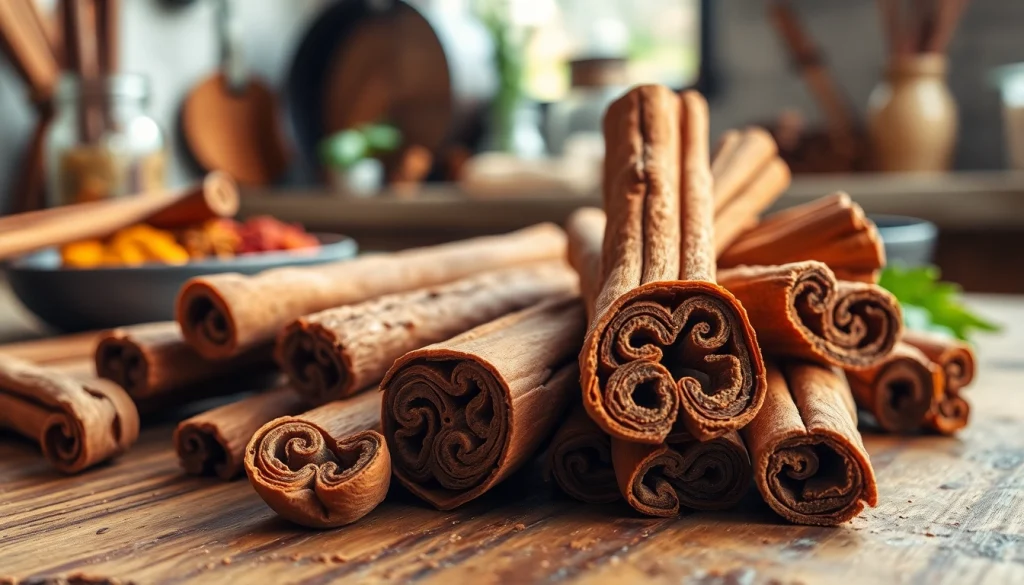Understanding Cinnamon Bark and Its Varieties
What is Cinnamon Bark?
Cinnamon bark is the inner layer of the bark from certain species of trees belonging to the genus Cinnamomum. It has been utilized for thousands of years for its culinary and medicinal properties. The aromatic qualities of cinnamon bark make it a highly sought-after spice, and its unique flavor adds depth to both sweet and savory dishes. Typically harvested by peeling the bark from the tree, the inner bark curls into quills when dried, while ground cinnamon is manufactured from the dried bark.
Types of Cinnamon Bark: Ceylon vs. Cassia
When discussing cinnamon bark, two main varieties emerge: Ceylon cinnamon and Cassia cinnamon. Ceylon cinnamon, also known as “true” cinnamon, is primarily sourced from Sri Lanka and possesses a delicate, complex flavor with sweet notes. In contrast, Cassia cinnamon, often labeled simply as cinnamon, is thicker, more pungent, and derived from trees found in various parts of Asia, particularly China and Indonesia. Both types can be found in stores, and while Ceylon is considered more premium due to its subtle flavor profile, Cassia remains the more common choice in grocery stores due to its lower price point.
Key Differences and Identification
Identifying the differences between Ceylon and Cassia cinnamon is crucial for anyone interested in culinary applications or health benefits. Ceylon has a lighter brown color and is often layered in a more crumbled fashion. In contrast, Cassia is darker and denser, featuring a hard texture that makes it more challenging to grind. Ceylon cinnamon also has a sweeter and less intense flavor, which many chefs prefer for desserts and pastries. When shopping for cinnamon bark, it’s important to check the label for type and authenticity, particularly since many products contain blends that can confuse consumers.
Health Benefits of Cinnamon Bark
Nutritional Profile of Cinnamon Bark
Cinnamon bark is not just a flavorful ingredient; it also packs a serious nutritional punch. Rich in antioxidants, including polyphenols, and possessing anti-inflammatory properties, cinnamon offers benefits that extend beyond its culinary appeal. A typical serving contains essential minerals such as calcium, iron, and magnesium, along with vitamins that contribute to overall health. The unique composition of cinnamon bark is what supports its reputation as a health-boosting spice.
Health Benefits Supported by Research
Numerous studies have highlighted the varied health benefits of cinnamon bark. Research indicates that it may help lower blood sugar levels by increasing insulin sensitivity, making it beneficial for those with type 2 diabetes. Furthermore, cinnamon is known for its potential antimicrobial properties, aiding the body in combating bacterial and fungal infections. Additional studies have suggested that cinnamon can improve heart health by reducing levels of total cholesterol, LDL cholesterol, and triglycerides, while simultaneously increasing HDL cholesterol.
Common Uses in Traditional Medicine
Throughout history, cinnamon bark has been used in traditional medicine across several cultures. In Ayurvedic practices, it has been employed as a remedy for digestive issues, respiratory ailments, and as a warming spice to combat colds. Its role in herbal medicine continues today, helping to manage effectively conditions such as diabetes, inflammation, and even certain types of pain. The tinctures and extracts derived from cinnamon bark have been suggested to stimulate the immune system and improve digestive health, thereby allowing for more holistic approaches to wellness.
Culinary Uses of Cinnamon Bark
Incorporating Cinnamon Bark in Recipes
Cinnamon bark can enhance dishes in a variety of culinary contexts. Its warm, sweet flavor makes it a beloved staple in baking—from cinnamon rolls to apple pies. It can also be added to savory dishes, particularly in Indian and Middle Eastern cuisine, where it’s commonly used in spice blends for curries and stews. Cinnamon bark pieces can infuse flavors when simmered in soups or beverages like chai. Notably, the use of whole sticks is recommended for long cooking processes, while ground cinnamon is ideal for batters and quick bakes.
Flavor Profiles and Pairings
The flavor profile of cinnamon bark lends itself to various pairings, enhancing both sweet and savory dishes. Classic combinations include cinnamon with apples, pears, and chocolate, while it also complements nutty flavors such as almonds and walnuts. In savory dishes, cinnamon can blend seamlessly with cumin, coriander, and cardamom, creating a rich, warm profile ideal for curries and robust stews. Understanding flavor pairings helps to maximize the use of cinnamon bark in both traditional recipes and innovative culinary creations.
Tips for Storage and Preservation
To maintain the potency and flavor of cinnamon bark, proper storage is crucial. Keep it in a cool, dark place, preferably in an airtight container to shield it from humidity and light. Whole cinnamon sticks can last up to two to three years, while ground cinnamon typically retains its best quality for six months to a year. Always check for signs of loss in aroma and flavor before using, as these are indicators that the spice may have deteriorated in quality.
Potential Side Effects and Precautions
Common Side Effects of Cinnamon Bark
While cinnamon bark is generally safe for most people when consumed in culinary quantities, excessive intake can lead to potential side effects. Some individuals may experience gastrointestinal complications such as nausea or upset stomach. Additionally, Cassia cinnamon contains coumarin, which can be harmful in large amounts, particularly for individuals with liver disease. Moderation is key to safely enjoying cinnamon as part of your diet.
Dosage Recommendations and Safety
For most adults, consuming up to one teaspoon (2-4 grams) of cinnamon per day is considered safe and can be beneficial. For those utilizing cinnamon bark for medicinal purposes, it’s prudent to consult with a healthcare professional to determine an appropriate dosage, especially if considering supplements. Pregnant or nursing women should also take care when consuming cinnamon and discuss it with their healthcare provider.
Interactions with Medications
Cinnamon may interact with certain medications, particularly those that affect blood sugar levels, such as insulin and other anti-diabetic medications. Individuals on anticoagulants or blood thinners should also be cautious, as high doses of cinnamon might increase the risk of bleeding. Being aware of potential interactions ensures safe use of cinnamon, particularly when incorporated into a dietary regimen alongside other medications.
Sourcing Quality Cinnamon Bark
Recognizing Authenticity in Cinnamon Bark Products
When purchasing cinnamon bark, differentiating between the various types is essential to ensure quality and authenticity. Authentic Ceylon cinnamon is often more expensive and can sometimes be found whole, while Cassia cinnamon is more prevalent in mainstream markets. Authentic cinnamon will typically have a softer texture and a sweeter aroma than its cassia counterpart. Always seek products that specify the origin and type on their labels to guarantee you are getting the best quality.
Ethical Sourcing and Production Practices
Sustainable and ethical practices in sourcing cinnamon bark are increasingly critical to consumers. Investigate brands that commit to sustainable practices, supporting local farmers and communities. Certifications such as Fair Trade or organic can also help guide choices for ethically sourced products. This not only contributes to environmental sustainability but also ensures fair compensation for local farmers who rely on cinnamon cultivation as their livelihood.
Where to Buy High-Quality Cinnamon Bark
High-quality cinnamon bark can be found at specialty spice shops, farmers’ markets, or through reputable online retailers. Opting for organic varieties may elevate quality and flavor, while supporting sustainable farming practices. When selecting a product, consider checking reviews and feedback from other buyers to ensure that the quality meets your expectations. For those looking for quality cinnamon bark, Cinnamon Bark from trusted sources offers an excellent choice.


